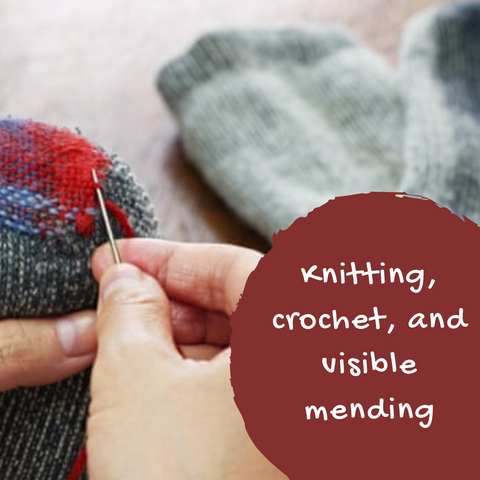
Knitting, crochet, and visible mending
When most of us think about mending clothes, it probably entails the darning of warn patches or holes in socks or an elbow or knee patch where the clothing item’s fabric is wearing out. This kind of mending was, more often than not, made in a manner where the mending could not be seen. Indeed, the clothing item was meant to look “good as new” once you were done mending.
However, visible mending has come to the forefront in the past few years to become a movement that doesn’t just mend clothing for the sake of making something last longer, but also as a means of protesting against the cycle of “fast fashion” that many of us seem stuck in as we seek to always wear the newest fashion that’s hit the streets.

Visible mending has also become a way of showing some of your personality to the world in the clothing that you choose to wear – rather than simply wearing something off the rack or making an item from scratch, you take an item that already exists and give it new life. In this way, it has become a part of the “slow fashion” movement.

One of the main unwritten “rules” of visible mending – the item must still have a practical use once you’re finished mending it. If it is a knitted item like socks or a sweater it should still be wearable, or if it’s a fabric item like denim pants, it must also still be wearable with the mending, in both cases, being able to withstand being worn on a nearly daily – or even daily – basis.
Sashiko – an age-old visible mending technique
Visible mending can use many techniques, and one that has become very popular, is Sashiko. A traditional Japanese embroidery technique, it is now taught the world over by artists like Miho Takeuchi and used as a beautiful means to mend fabric so that it can still be used practically.
Here is a video about the history of Sashiko as well as some of the techniques:
Mending has been a disappearing art because of the easy ways that we can now get a hold of clothing as well as the low prices of much of the clothing. However, if you’re an avid knitter or crocheter, knowing how to fix knitting or crochet that is wearing thin will help to keep your handiwork usable for longer. You may even decide to mend items that you have been given or inherited in this way.
Sock darning forms a good basis for the way in which darning works, so let’s begin there.
How to darn your socks and make them good as new (or even better!)
To be able to darn your socks, you will need a darning needle (a needle with a slightly bent tip) – a tapestry needle can be used as well – that is suitable for the weight of yarn that you’re going to use to fix the socks (most likely sock weight yarn or cotton), as well as the actual yarn or cotton that you’re going to use for darning. You will also need what is casually called a mushroom, or darning mushroom. You can also use a darning egg.
Here is a tutorial showing how a darning mushroom is used when darning a sock:
Now that you’ve seen how a sock can be darned with the same – or very similar yarn – you can experiment using contrasting yarn or yarn in your favorite color to visibly darn and mend the sock, like this video shows:
Using much the same technique, you can also darn sweaters, scarves, afghans, and shawls that has been knitted or crocheted. Some yarn lovers and artists even use sweaters or other wool items that have been attacked by moths and turn the holes into a canvas for their imagination to go wild on.
Rather than hide the damage that time has done, the damage is celebrated as its own kind of beauty.
In this video a technique is shown that mimics the knitted fabric instead of using the weaving technique usually used for darning:
Finally, here is a tutorial that shows how to actually knit a patch to fix a hole worn into socks. The same technique can be used for other knitted items:
If you’re looking for some inspiration for all the different darning and mending techniques that’s being used for visible mending, a visit to your Pinterest page will give you oodles of ideas and inspiration.
Be sure to share your visible mending with us on Facebook or Instagram

